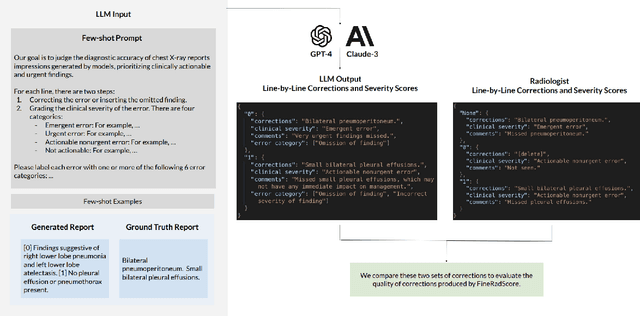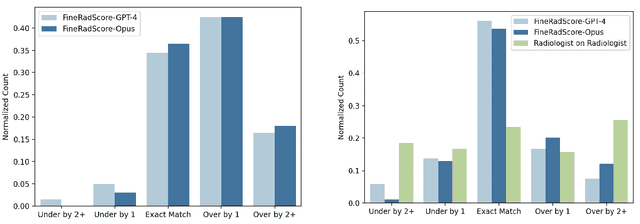Alyssa Huang
FineRadScore: A Radiology Report Line-by-Line Evaluation Technique Generating Corrections with Severity Scores
May 31, 2024



Abstract:The current gold standard for evaluating generated chest x-ray (CXR) reports is through radiologist annotations. However, this process can be extremely time-consuming and costly, especially when evaluating large numbers of reports. In this work, we present FineRadScore, a Large Language Model (LLM)-based automated evaluation metric for generated CXR reports. Given a candidate report and a ground-truth report, FineRadScore gives the minimum number of line-by-line corrections required to go from the candidate to the ground-truth report. Additionally, FineRadScore provides an error severity rating with each correction and generates comments explaining why the correction was needed. We demonstrate that FineRadScore's corrections and error severity scores align with radiologist opinions. We also show that, when used to judge the quality of the report as a whole, FineRadScore aligns with radiologists as well as current state-of-the-art automated CXR evaluation metrics. Finally, we analyze FineRadScore's shortcomings to provide suggestions for future improvements.
Safeguarding Data in Multimodal AI: A Differentially Private Approach to CLIP Training
Jun 13, 2023



Abstract:The surge in multimodal AI's success has sparked concerns over data privacy in vision-and-language tasks. While CLIP has revolutionized multimodal learning through joint training on images and text, its potential to unintentionally disclose sensitive information necessitates the integration of privacy-preserving mechanisms. We introduce a differentially private adaptation of the Contrastive Language-Image Pretraining (CLIP) model that effectively addresses privacy concerns while retaining accuracy. Our proposed method, Dp-CLIP, is rigorously evaluated on benchmark datasets encompassing diverse vision-and-language tasks such as image classification and visual question answering. We demonstrate that our approach retains performance on par with the standard non-private CLIP model. Furthermore, we analyze our proposed algorithm under linear representation settings. We derive the convergence rate of our algorithm and show a trade-off between utility and privacy when gradients are clipped per-batch and the loss function does not satisfy smoothness conditions assumed in the literature for the analysis of DP-SGD.
 Add to Chrome
Add to Chrome Add to Firefox
Add to Firefox Add to Edge
Add to Edge